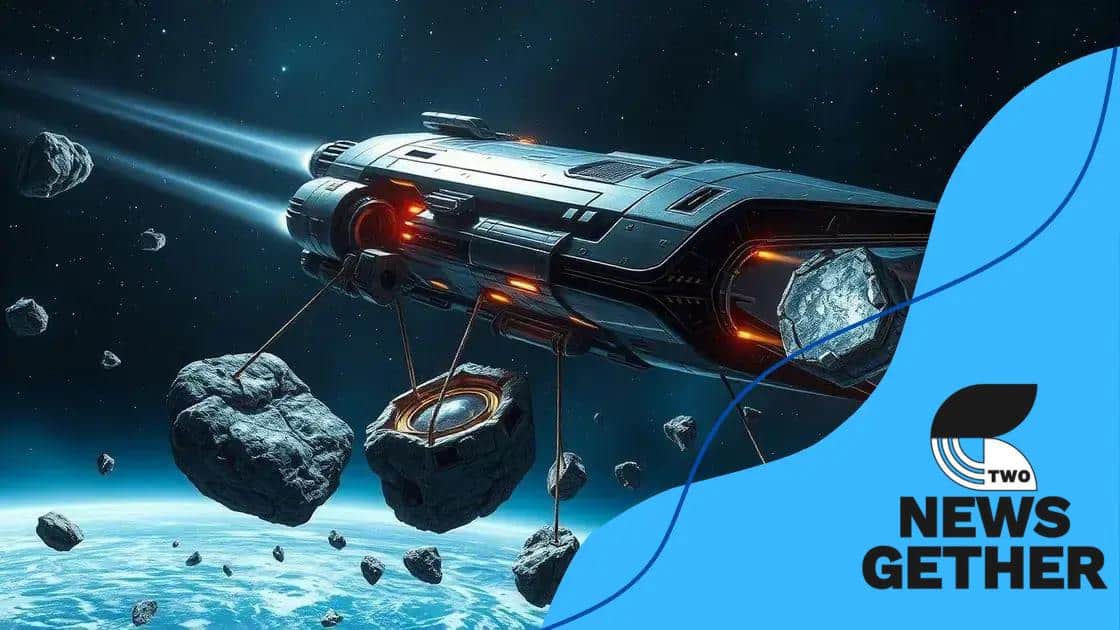Advances in space mining and its economic potential

Advances in space mining unlock access to valuable resources beyond Earth, offering significant economic potential while facing challenges related to technology, legal frameworks, and environmental impacts.
Advances in space mining and its economic potential are not just science fiction anymore. As we look to the stars, new opportunities are emerging that could change our understanding of resources and commerce.
Understanding space mining: what it involves
Understanding space mining is crucial as humanity expands its reach beyond Earth. It involves the extraction of valuable minerals and resources from celestial bodies like asteroids and planets. These resources can include metals such as platinum, gold, and other essential materials needed for technology and construction.
Key Aspects of Space Mining
Space mining presents various opportunities and challenges. First, the technology for extracting resources is constantly evolving. From robotic spacecraft to advanced drilling equipment, innovative developments are paving the way for successful mining operations.
Technological Innovations
- Robotic Systems: Autonomous robots will handle extraction and processing tasks.
- Transportation: Efficient spacecraft will be designed to transport materials back to Earth.
- Resource Identification: Advanced scanning technologies help identify valuable resources on asteroids.
Moreover, the economic potential of space mining is immense. By tapping into resources beyond our planet, we could create new industries, jobs, and technologies. For example, the use of space resources in building infrastructure on the Moon or Mars could significantly reduce costs and reliance on Earth.
However, challenges such as the legal framework surrounding mining in space need addressing. International agreements must evolve to manage these activities responsibly.
Environmental Considerations
There are also environmental impacts that need careful thought. Extracting resources in space might seem distant from concerns on Earth, yet potential impacts must be evaluated. Protecting celestial bodies from contamination or exploitation is essential for the sustainability of our solar system.
In summary, understanding space mining involves recognizing its potential benefits and associated challenges. As we stand on the brink of a new frontier, we must navigate this exciting landscape wisely.
The technologies driving space mining advances
The technologies driving space mining advances are transforming our ability to access resources beyond Earth. These innovations include robotic systems, advanced propulsion methods, and automation technologies. Each plays a crucial role in making space mining feasible and efficient.
Robotic Systems
Robotic systems are at the forefront of space mining. They can operate in the harsh conditions of space, reducing the need for human presence. These robots are designed for tasks such as drilling, extracting, and transporting materials. Additionally, they can work autonomously, allowing for continuous operation without delays.
Advanced Propulsion
- Ionic Thrusters: These are more efficient and can operate over long distances without needing large amounts of fuel.
- Chemical Propulsion: Used for main propulsion systems, suitable for launching spacecraft from Earth.
- Nuclear Thermal Propulsion: Offers greater thrust, enabling faster missions to mining sites.
Alongside robots, advanced propulsion technology significantly enhances the ability to reach asteroids and other celestial bodies more effectively. Innovations like ionic thrusters allow spacecraft to travel long distances with minimal fuel.
Automation also plays a significant part in these technologies. Automated systems can conduct remote mining operations, minimizing risks and maximizing output. With such advancements, we can tap into resources that were once considered inaccessible.
Data and Communication
The role of data in space mining cannot be overlooked. Enhanced communication systems help relay information from distant mining sites back to Earth. This ensures that operations can be monitored and adjusted in real-time, leading to greater efficiencies.
With the combination of robotics, advanced propulsion, and automation, the landscape of space mining is changing rapidly. These technologies not only make extraction possible but also pave the way for a new era of space exploration.
Economic benefits of space resources

The economic benefits of space resources are vast and varied. As we venture into space mining, we unlock a treasure trove of materials that can revolutionize industries on Earth. These resources include precious metals like platinum, which are rare and highly valuable.
Market Expansion
With increased access to these materials, new markets will emerge. Industries such as electronics, aerospace, and energy will see a boost. For instance, precious metals obtained from asteroids can reduce production costs for electronics, making products more affordable for consumers.
Job Creation
- Mining Operations: Establishing mining sites will require skilled workers.
- Research and Development: Innovations in technology will demand engineers and scientists.
- Transport and Logistics: New roles will open in the transportation of materials back to Earth.
The growth of the space mining industry will create numerous job opportunities. As companies invest in innovative technologies, a demand for skilled professionals will rise. This includes engineers, scientists, and technicians who specialize in aerospace technologies.
Furthermore, utilizing space resources can lead to a decrease in our reliance on terrestrial mining. This not only helps preserve Earth’s natural resources but also minimizes environmental impacts associated with mining activities. Sustainable practices can be implemented in space mining that are less damaging compared to traditional methods.
Global Collaboration
The pursuit of space resources fosters international partnerships. Countries will need to work together to establish legal frameworks and share technologies. This collaboration can lead to peaceful relations and a shared vision for exploring space.
In summary, the economic benefits of space resources extend far beyond immediate profits. They pave the way for a sustainable future, fostering innovation, job creation, and global cooperation.
Challenges and risks in space mining
Challenges and risks in space mining are significant factors that need careful consideration. As we explore this frontier, we face technical, legal, and environmental issues that require innovative solutions.
Technical Challenges
One of the main technical challenges involves the harsh conditions of space. Equipment must withstand extreme temperatures, radiation, and microgravity. Engineers must develop materials and designs that are durable and reliable under these conditions.
Legal and Regulatory Issues
- Ownership Rights: Determining who owns the resources extracted from asteroids can create conflicts.
- International Agreements: Currently, space law is not well-defined, leading to uncertainty in operations.
- Compliance: Companies must navigate complex regulations governing space activities.
The legal framework surrounding space mining is still evolving. With many countries entering the field, disputes over ownership and rights can arise. Establishing clear laws is essential to avoid conflicts and promote cooperation among nations.
Moreover, there are environmental risks to consider. Mining activities could potentially contaminate celestial bodies or disrupt their natural state. This raises concerns about protecting these bodies for future exploration and scientific research.
Financial Risks
Investing in space mining operations involves considerable financial risk. Developing the necessary technology and infrastructure requires substantial upfront investment. There is no guarantee of resource recovery, which could lead to financial losses for investors.
In addition, the expensive logistics of transporting equipment and materials from Earth to mining sites present a major hurdle. As these challenges become apparent, companies must carefully assess the viability of their operations.
Addressing the challenges and risks in space mining will require collaboration among nations, private companies, and legal experts. With focused efforts, we can overcome these obstacles and unlock the potential of resources beyond Earth.
Future prospects for the space mining industry
The future prospects for the space mining industry are bright and full of potential. As technology advances, the ability to extract valuable resources from celestial bodies is becoming more feasible. This sector could open new avenues for economic growth and innovation.
Technological Advancements
Continued research and development in robotics and automation will likely enhance mining capabilities. Breakthroughs in propulsion technology will shorten travel times to asteroids and other mining targets. As these technologies evolve, space mining operations will become more efficient and cost-effective.
Increased Investment
- Private Sector Involvement: More companies are investing in space mining technologies.
- Government Support: Governments are beginning to recognize the potential economic benefits and are providing funding.
- International Partnerships: Collaborations among countries could lead to shared resources and knowledge.
Growing interest from both private companies and government agencies indicates a robust future for the space mining industry. International partnerships may emerge, benefiting all parties involved and creating a collaborative environment for exploring space resources.
As companies begin to extract materials from asteroids, the economic landscape will shift. The availability of rare minerals could significantly reduce costs in various industries, such as electronics and construction. This shift may lead to lower prices for consumers and stimulate further technological advancements.
Environmental and Ethical Considerations
While the future is promising, ethical and environmental considerations must also be addressed. Developing regulations to ensure that space mining activities are sustainable is crucial. This includes protecting celestial bodies from contamination and ensuring responsible resource management.
In conclusion, the future prospects for the space mining industry hold great promise, but careful planning is essential. Balancing innovation with responsibility will determine the success and sustainability of this emerging sector.
FAQ – Frequently Asked Questions about Space Mining
What are the main benefits of space mining?
Space mining can provide access to rare resources, reduce costs in various industries, and stimulate economic growth.
What challenges does the space mining industry face?
The industry faces technical, legal, and environmental challenges, including equipment durability and ownership rights.
How is technology improving space mining operations?
Advancements in robotics, propulsion systems, and automation are making space mining more efficient and feasible.
Why is international cooperation important for space mining?
International cooperation is essential for establishing regulations, sharing knowledge, and promoting peaceful exploration of space resources.






